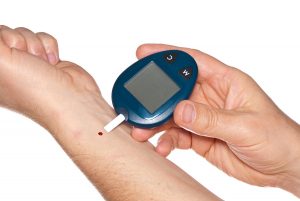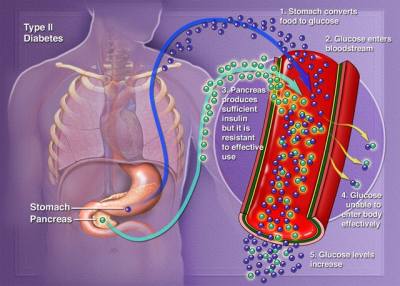A 20-year study showed that close diabetes control prolongs life. A study divided 160 people with diabetes into two groups. The one group continued to get standard care. Yet the other group received a multi targeted, aggressive treatment protocol. As a result after 20 years the group with the intensive treatment protocol lived 7.9 years longer than the group with the standard treatment.
Dr. Oluf Pederson was the senior investigator of the physician team that followed the diabetes group. He said that they concentrated on a number of known adverse factors and treated them aggressively. These factors were first of all high blood glucose values and clotting risks, also high blood pressure and high triglycerides and in addition cholesterol values. Behavior modification was the therapeutic method to get people with risk factors to exercise more, adopt a healthy diet and stop smoking. Medication in select cases also played a role.
More details about the study
The intervention of intensive treatment lasted 8 years. After that the patients were still in a follow-up study for 13 years. At the beginning of the study patients were on average 55 years old and were borderline obese.
The investigation team screened for complications of diabetes. This included screening for kidney disease, heart disease and blindness. Dr. Joel Zonszein, the director of the New York Clinical Diabetes Center at Montefiore Medical Center said: ”These results are impressive and most patients do not receive the correct treatment, according to national surveys.”
Other studies about diabetes
Foreign studies
Study from Croatia
- Another study from Croatia involved 200 patients. It concentrated on patients who did not respond to metformin. Physicians used alternative treatment modalities, and they observed and measured blood sugars and hemoglobin A1C in the following 6 months. The study concluded that those patients who received aggressive treatment of their condition did better than those who did not receive the same vigorous approach.
Study from Japan
- This Japanese study documented that female patients with type-2 diabetes developed kidney damage earlier than their male counterparts. Consequently, the investigators pointed out how important it is to treat diabetes aggressively to avoid kidney damage.
Study from Singapore
- This 2016 study from Singapore analyzed retroactively the impact of diabetes on the long-term survival after coronary bypass grafting (CABG). 5720 consecutive patients had their isolated first CABG surgery between 1982 and 1999. The mean follow-up was 13 years. 34.6% of the patients had diabetes, 51% had high blood pressure and 46.6% had elevated blood lipids. The initial mortality after the CABG surgery was 2.4% in the diabetic group and 1.8% in the non-diabetic group. 20-year survival rates following CABG surgery were 30.9% in diabetics and 49.2% in the non-diabetics, an 18.3% difference. The 20-year freedom from cardiac mortality rates was 56% in diabetics and 68.4% in non-diabetics. Other risk factors that led to cardiac mortality were the following: female gender (1.43-fold risk), diabetes (1.51-fold risk), previous heart attack (1.54-fold risk) and a low left ventricular ejection fraction of less than 35% (2.6-fold risk). The conclusion from this study was that long-term survival in diabetics following CABG surgery was much lower than that of non-diabetic controls. Hence the key to improving long-term survival for diabetics is to treat comorbidities like high blood pressure and elevated lipids aggressively as well as getting blood sugars and hemoglobin A1C values under control.
US studies
- In this US study 558 youth (age less than 21) between February 2012 to July 2015 received follow-up. Between 40% and 50% of these diabetics needed insulin to improve their diabetes. Unfortunately their diabetes showed poor control, as their high hemoglobin A1C values indicated. Median HbA1C was 6.7%, 8.5%, 9.6%, and 9.7% in those with disease duration less than 1 year, 1-2 years, 2-3 years and less than 4 In other words, the longer the young patients had diabetes, the less seriously they took their treatment. Only 33% treated their high blood pressure and only 11% their elevated blood lipids. Microalbuminuria, an indicator of diabetic kidney disease, and non-alcoholic fatty liver disease were present in 5% to 6% of these young diabetic patients. The authors came to the conclusion that there were serious gaps in treating these young diabetics. Further follow-up data of the same group of patients in the coming years will provide further data. In conclusion, the new hemoglobin A1C ranges of 3.8% to 4.9% as the new normal range explains why these youths who do not treat their diabetes properly are at high risk to develop complications from their poorly controlled diabetes.
Heart attacks and erectile dysfunction
- Heart attacks are more common among patients with uncontrolled diabetes. This US study classified diabetics according to the tightness of their diabetes control. Researchers found examining 606 men and 606 women with diabetes that they could reduce their risk of a heart attack, if they controlled smoking, glycated hemoglobin (hemoglobin A1C), systolic blood pressure, and total and high-density lipoprotein cholesterol. The control of all these risk factors could contribute to the prevention of heart attacks. 35% of men and 45% of women could prevent having a heart attack. A laxer control still would prevent 36% of heart attacks in men and 38% in women. A very aggressive diabetes control could prevent 51% of heart attacks in men and 61% in women. Most noteworthy: close diabetes control prolongs life.
- Erectile dysfunction (ED) is a big problem among diabetic men. This study from Seattle shows the investigation of 136, 306 men with erectile dysfunction. 19, 236 of these men had diabetes prior to their ED problem. Over a two-year observation period diabetic men had much worse ED problems. As a result they needed to receive secondary line treatments like penile suppositories or injectables. Others needed tertiary treatments like penile prostheses. In those whose diabetes control was good, oral agents as first-line therapies were usually sufficient.
More studies about risks and benefits of lifestyle
- Middle-aged women with diabetes have a 4- to 5-fold higher risk for developing heart attacks while men do not show such a higher risk. It is probably particularly important for women to control diabetes when they are diagnosed with it to reduce the risk of coming down with a heart attack.
- In 2011 Taylor from Newcastle University showed in a group of diabetes patients that he could cure diabetes permanently with an extremely low calorie diet. The trial was simple: he took overweight or obese patients with diabetes and put them on a starvation diet of 600-700 calories per day for 8 weeks. Consequently 43% of diabetic patients received a permanent cure of their diabetes. More info: http://nethealthbook.com/news/cure-diabetes-permanently/
Conclusion
The new hemoglobin A1C ranges that are desirable are between 3.8% to 4.9%. When diabetics bring their hemoglobin A1C level into this range, they do not get complications from their previously poorly controlled diabetes. Close diabetes control prolongs life. But as can be seen from a brief review of the literature physicians tend to be lax, patients are lax, and diabetes is often not well controlled. This leads to erectile dysfunction in males, to heart attacks and kidney failure in both sexes. Blindness and painful diabetic neuropathy are also common complications of poorly controlled diabetes. Amputations from clogged arteries are also among the complications. “Close diabetes control prolongs life” is the new mantra that everybody with diabetes needs to follow.
Lifestyle changes control diabetes and prolong life
As stated above Dr. Taylor from Great Britain has shown that a brief 600 to 700 calorie diet can cure 43% of diabetic patients permanently. Quit smoking, bring the glycated hemoglobin (hemoglobin A1C) into the normal range, control your systolic blood pressure as well as your total and high-density lipoprotein cholesterol. Do all these things, exercise regularly, and your diabetes will be well controlled. Remember: close diabetes control prolongs life!















